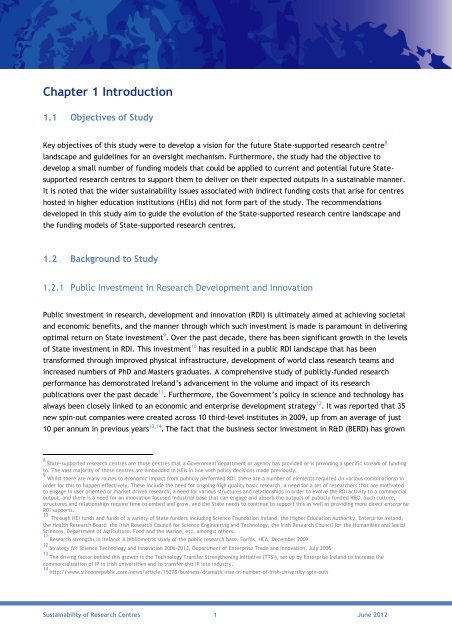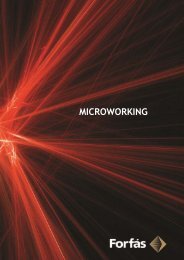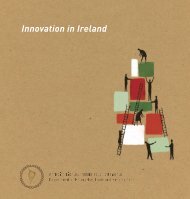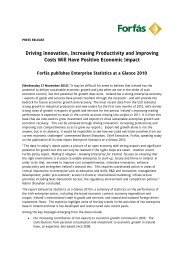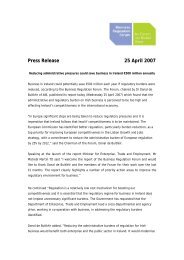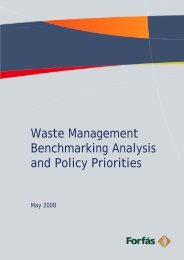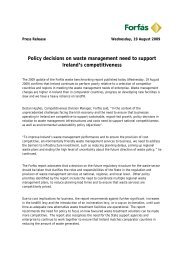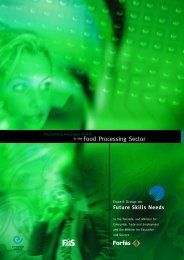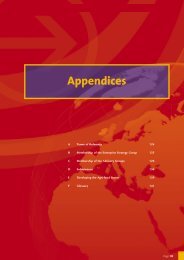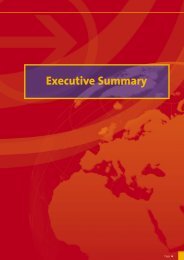Sustainability of Research Centres - Advisory Science Council
Sustainability of Research Centres - Advisory Science Council
Sustainability of Research Centres - Advisory Science Council
You also want an ePaper? Increase the reach of your titles
YUMPU automatically turns print PDFs into web optimized ePapers that Google loves.
Chapter 1 Introduction<br />
1.1 Objectives <strong>of</strong> Study<br />
Key objectives <strong>of</strong> this study were to develop a vision for the future State-supported research centre 8<br />
landscape and guidelines for an oversight mechanism. Furthermore, the study had the objective to<br />
develop a small number <strong>of</strong> funding models that could be applied to current and potential future State-<br />
supported research centres to support them to deliver on their expected outputs in a sustainable manner.<br />
It is noted that the wider sustainability issues associated with indirect funding costs that arise for centres<br />
hosted in higher education institutions (HEIs) did not form part <strong>of</strong> the study. The recommendations<br />
developed in this study aim to guide the evolution <strong>of</strong> the State-supported research centre landscape and<br />
the funding models <strong>of</strong> State-supported research centres.<br />
1.2 Background to Study<br />
1.2.1 Public Investment in <strong>Research</strong> Development and Innovation<br />
Public investment in research, development and innovation (RDI) is ultimately aimed at achieving societal<br />
and economic benefits, and the manner through which such investment is made is paramount in delivering<br />
optimal return on State investment 9 . Over the past decade, there has been significant growth in the levels<br />
<strong>of</strong> State investment in RDI. This investment 10 has resulted in a public RDI landscape that has been<br />
transformed through improved physical infrastructure, development <strong>of</strong> world class research teams and<br />
increased numbers <strong>of</strong> PhD and Masters graduates. A comprehensive study <strong>of</strong> publicly-funded research<br />
performance has demonstrated Ireland’s advancement in the volume and impact <strong>of</strong> its research<br />
publications over the past decade 11 . Furthermore, the Government’s policy in science and technology has<br />
always been closely linked to an economic and enterprise development strategy 12 . It was reported that 35<br />
new spin-out companies were created across 10 third-level institutes in 2009, up from an average <strong>of</strong> just<br />
10 per annum in previous years 13,14 . The fact that the business sector investment in R&D (BERD) has grown<br />
8<br />
State-supported research centres are those centres that a Government department or agency has provided or is providing a specific stream <strong>of</strong> funding<br />
to. The vast majority <strong>of</strong> these centres are embedded in HEIs in line with policy decisions made previously.<br />
9<br />
Whilst there are many routes to economic impact from publicly performed RDI, there are a number <strong>of</strong> elements required (in various combinations) in<br />
order for this to happen effectively. These include the need for ongoing high quality basic research, a need for a set <strong>of</strong> researchers that are motivated<br />
to engage in user oriented or market driven research, a need for various structures and relationships in order to evolve the RDI activity to a commercial<br />
output, and there is a need for an innovation focused industrial base that can engage and absorb the outputs <strong>of</strong> publicly funded R&D. Such culture,<br />
structures and relationships require time to embed and grow, and the State needs to continue to support this as well as providing more direct enterprise<br />
RDI supports.<br />
10<br />
Through HEI funds and funds <strong>of</strong> a variety <strong>of</strong> State funders including <strong>Science</strong> Foundation Ireland, the Higher Education Authority, Enterprise Ireland,<br />
the Health <strong>Research</strong> Board the Irish <strong>Research</strong> <strong>Council</strong> for <strong>Science</strong> Engineering and Technology, the Irish <strong>Research</strong> <strong>Council</strong> for the Humanities and Social<br />
<strong>Science</strong>s, Department <strong>of</strong> Agriculture, Food and the Marine, etc. amongst others.<br />
11<br />
<strong>Research</strong> strengths in Ireland: A bibliometric study <strong>of</strong> the public research base, Forfás, HEA, December 2009<br />
12 Strategy for <strong>Science</strong> Technology and Innovation 2006-2013, Department <strong>of</strong> Enterprise Trade and Innovation, July 2006<br />
13<br />
The driving factor behind this growth is the Technology Transfer Strengthening Initiative (TTSI), set up by Enterprise Ireland to increase the<br />
commercialization <strong>of</strong> IP in Irish universities and to transfer this IP into industry.<br />
14<br />
http://www.siliconrepublic.com/news/article/15278/business/dramatic-rise-in-number-<strong>of</strong>-irish-university-spin-outs<br />
<strong>Sustainability</strong> <strong>of</strong> <strong>Research</strong> <strong>Centres</strong> 1 June 2012


